Stuck in a constant battle to motivate your piano students to work on scales, technique or theory? If so, I have a secret solution to share with you. So lean in close…
You need a challenge board.

The challenge board is my magic pixie dust. It’s what keeps my students striving for better, even with the “boring” stuff which might otherwise get left by the wayside.
The content in this article was originally written in May 2016 and November 2017. It was revised and updated with substantially new content in April 2021.
The Idea
Like most piano teachers, I used to come up with all sorts of different practice rewards, challenges and themes to motivate my piano students. One would last for a few months, then I’d start a new one. But I was starting to getting frustrated with this wash, rinse, repeat approach.
It wasn’t that the challenges weren’t working, or that anything was wrong with them per se.
But they felt disjointed. More than that, they didn’t feel very musical or like they were teaching transferable skills.
That’s when the idea of a more consistent program – the challenge board and stickers – was born.
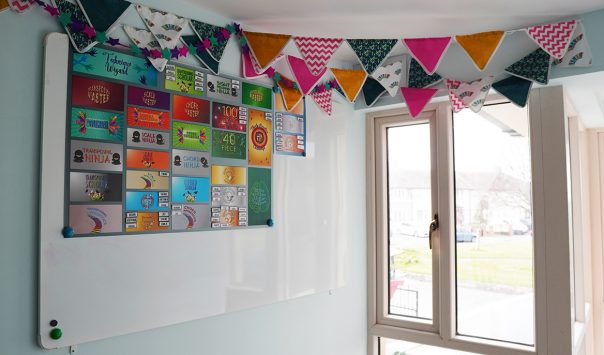
This idea was inspired by the badges earned by girl scouts and boy scouts. Like the scouts’ badges, the challenges on my board have set, specific and measurable goals. There’s also an element of social proof, as students can see what others have achieved so far.
The Results
Fast forward more than 5 years, and this experiment has worked out exactly as I planned.
Kids love earning a new spot on the board and adding to their sticker collection. They also put in considerably more effort to learn something when they know they’re close to completing a challenge.
I don’t need a gifts, special treats or a prize box to motivate my piano students. Glory really is the best prize!
I’m not naive – this won’t motivate all students. Nothing can be perfect for everyone. But the challenge board comes closer than any other motivational strategies I’ve tried.
How does the challenge board work?
I attached the posters to a metal whiteboard and put my students’ names on magnets. I had the stickers printed at moo.com.
The rules I use for each challenge are different, but they all motivate piano students to focus on a skill they might otherwise ignore (…ahem, scales, anyone?) Whenever a student conquers a challenge, they earn a place on the board and a sticker for their folder.
You can set your own rules for each challenge to suit your studio or, if you’re in our membership program for teachers – Vibrant Music Teaching – you can instantly access all the resources I use for my own studio from the VMT Library.
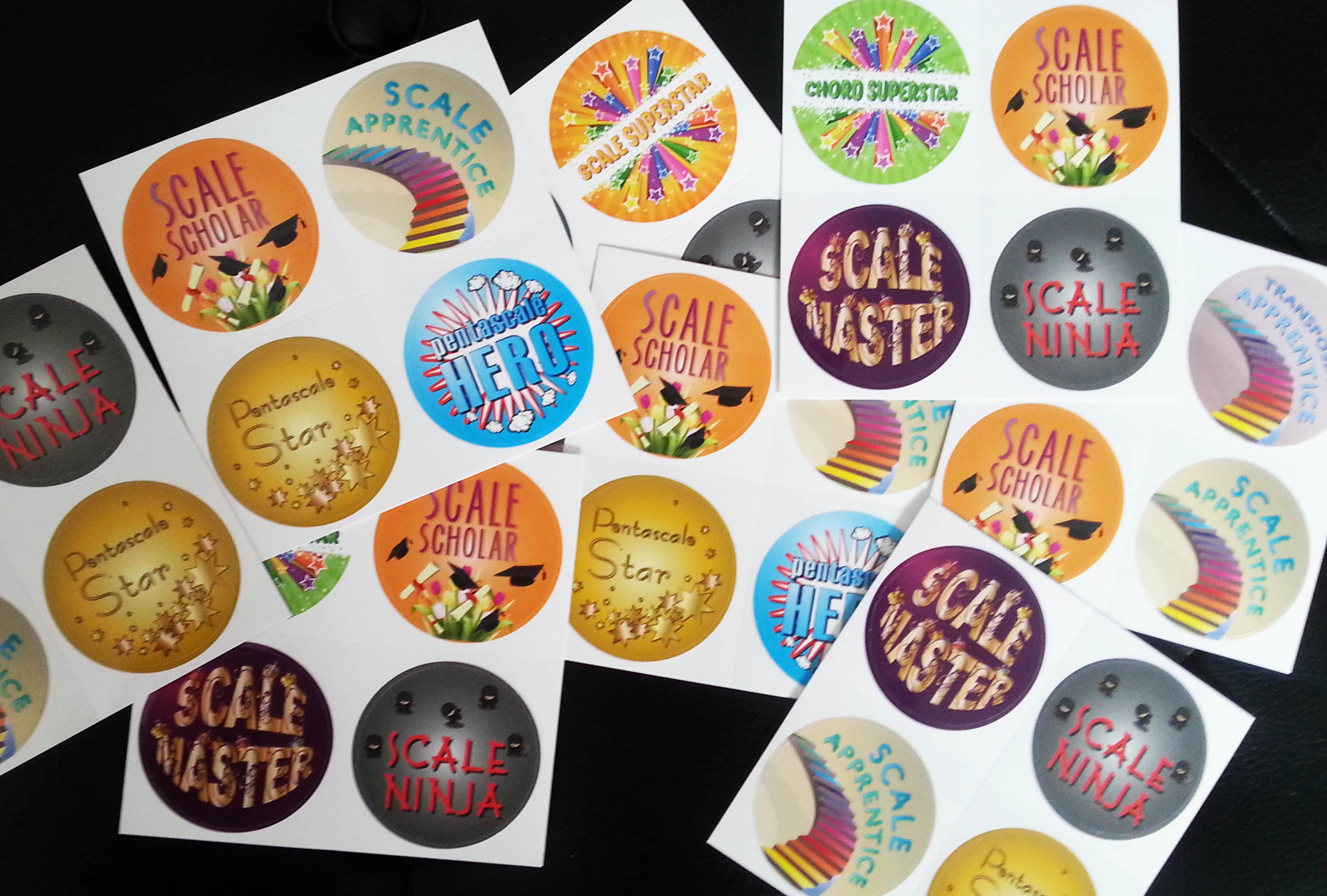
Subscribe to the newsletter and get the challenge posters and stickers
Enter your details to subscribe to the newsletter for piano teachers with information, tips and offers.
I hate spam as much as you do! I will only send you emails related directly to piano teaching and you can unsubscribe at any time.
Members can instantly download the full set of posters and stickers, including individual posters for each challenge.
Not a Vibrant Music Teaching member yet? This is the perfect time for you to check out the membership program for teachers. Keep reading for to see just a tiny sliver of the treasure trove available to members!
What’s included on my challenge board?
I couldn’t cover every area of piano studies on the board, so I had to pick and choose which ones I thought were the most likely to need an extra push. After all, activities such as improvisation and composition are super important…but I don’t exactly have to beg students to take part in those!
The areas I decided to cover were:
If you’re after something specific, click on any of the areas above to jump straight to that topic.
Scales
I’ve blogged about my scale levels before. The idea for establishing different levels of scales was really the tiny seed my entire challenge board sprouted from. I wanted my students to keep practicing scales – not just for exams, but as a regular part of their routine.
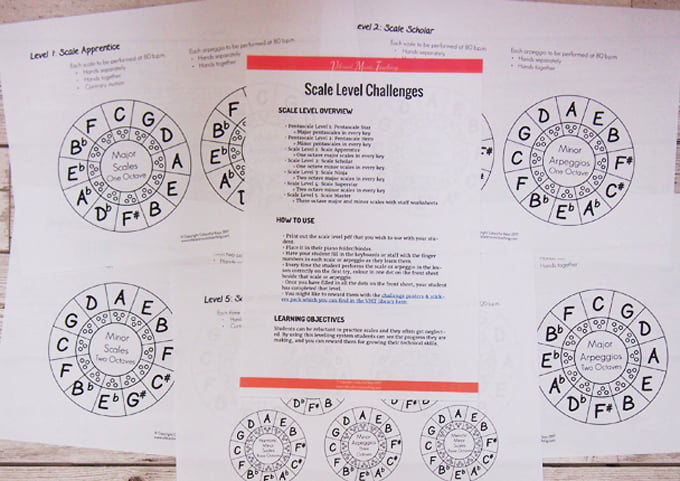
In the VMT Library, members can access charts and booklets for different types of scales by typing ‘scales challenge’ in the search box.
Chords
I’m a big advocate of teaching theory through playing wherever possible. So for my chords challenges, I decided that I want my students to be able to play the chords in each level effortlessly. After all, once students are comfortable playing the chords, the notation side of things becomes much easier.
VMT members can access the chords challenge booklet instantly from the VMT library, along with backing tracks and an iReal Pro playlist to add some excitement to students’ chords practice.
Sight Reading
At first, I used the sight reading cards and books from Piano Safari for my sight reading challenges. There are 3 levels in the Piano Safari method, which perfectly correlate to the 3 sight reading achievement levels on my challenge board.
I still use the Piano Safari levels for the sight reading challenges with many of my students. But I’ve also developed another sight reading curriculum called Reading Railroad.
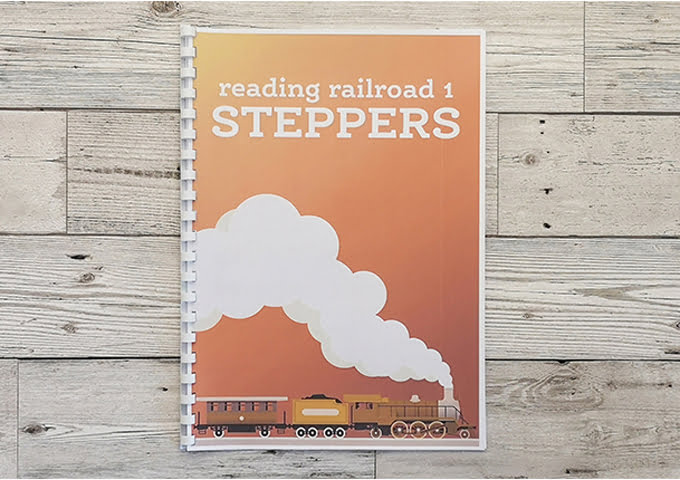
I like the Reading Railroad approach not only because it has a screen option to use for online lessons, but also because every sight reading exercise has its own coordinating backing track. Backing tracks encourage my students to keep going even if they make a mistake or they’re not certain about something.
There are 6 levels in the Reading Railroad curriculum, so my students conquer a sight reading challenge on the board each time they finish 2 levels of Reading Railroad.
Are you a member of Vibrant Music Teaching? Head over to the VMT Library and type ‘reading railroad’ in the search box to access the printable booklets, backing tracks and google slides.
Transposing
Transposing may seem like an odd choice to include on the challenge board, but I think it fits in perfectly with scales and chords. Getting to know all the major keys takes time, and it’s worth being thorough so that students call fall back on that knowledge when playing from notation and when improvising or arranging.
In my studio, I use folk songs and common melodies to help students work on transposing by ear – which means the transposing challenges double as incognito aural skills challenges 🤫.
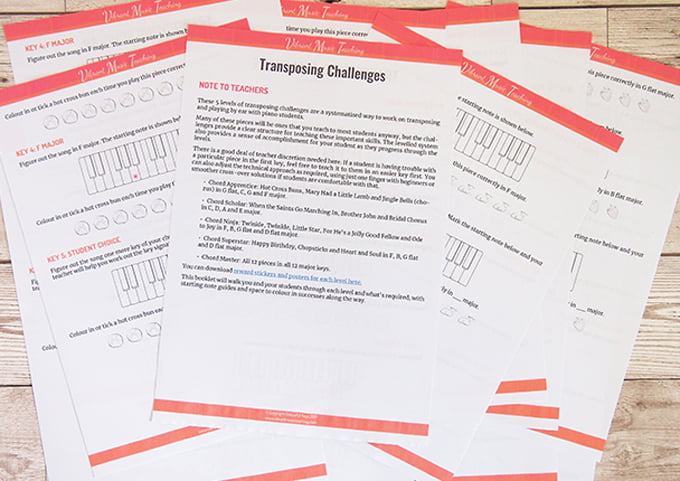
In the VMT Library, members can access booklets with the 5 levels of transposing challenges which give teachers a clear structure to teach students how to play 12 common melodies, each one in all 12 major keys. Not a member? Join today!
Note Names
These flashcard challenges were inspired by Susan Paradis’ ‘One Minute Club’. I altered her approach a little to create three distinct levels, but the idea is essentially the same. Students have to name and play a certain number of notes in under 60 seconds, 3 weeks in a row to conquer a “60 Second Challenge”
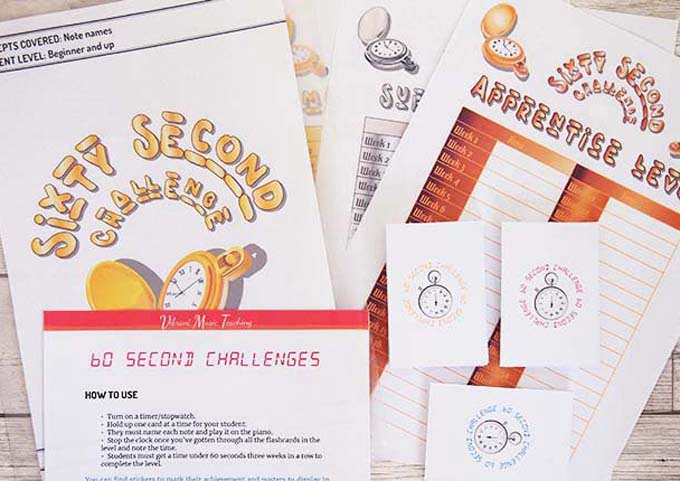
If you’re part of the VMT membership program, hop over to the library to access tracking sheets, flash cards and screen-option files for the 60 Second Challenges.
Technique
I base the parameters of the technique challenge on whichever method book or other technique program my student is working on.
- For Piano Safari, they would achieve this when they can demonstrate mastery of all the animal techniques
- If the student is using ‘Technique Trainer’ by Jackie Sharp, they would be able to confidently perform any of the basic exercises in that book.
You can easily adapt this to any technique approach you prefer in your teaching – whatever a “technique wizard” looks like to you.
If you’re a VMT member and you’re using Piano Safari for the Technique Wizard challenge, you might like these Piano Safari Tracking Charts from the VMT Library.
Practice
The 6 challenge categories above won’t make a bit of difference if your students aren’t practising, which is why I included 4 challenges specifically targeting these key practice areas: routine, focus, variety and memorisation.
Need help fostering better practice habits in your students? My hub page devoted to ‘Teaching Piano Practice’ has just what you need!
100 Days of Practice
This was started by the Piano Explorer magazine. I think it’s pretty self-explanatory! The point of the 100 Day Challenge is habit creation: making piano just a regular and consistent part of their normal routine.
I mostly use this challenge for students who are in their first year of lessons, to get them off to a great start. Of course how they practice is also important, but this is a good lesson in persistence and routine.

Are you a VMT member? If so, grab the 100 Day Practice Challenge tracking chart instantly from the Vibrant Music Teaching Library.
40 Piece Challenge
If you haven’t heard of the 40 Piece Challenge, you’re in for a treat! It was started by Elissa Milne in Australia, and has spread around the world because of its simplicity and effectiveness. I use this challenge primarily with my teenage intermediate students, especially when they’re stuck in an exam rut.
Thirty Practice Bull’s Eyes
The idea behind the Thirty Practice Bull’s Eyes challenge is to motivate piano students to focus on the results of their practice time rather than time spent or repetitions played. Setting practice targets is a great way to keep students on track and achieving concrete progress during their practice time.
To complete this challenge, students must successfully achieve 30 practice targets during a set period of time (I suggest 10-15 weeks, which would be 2 or 3 bull’s eyes each week.)
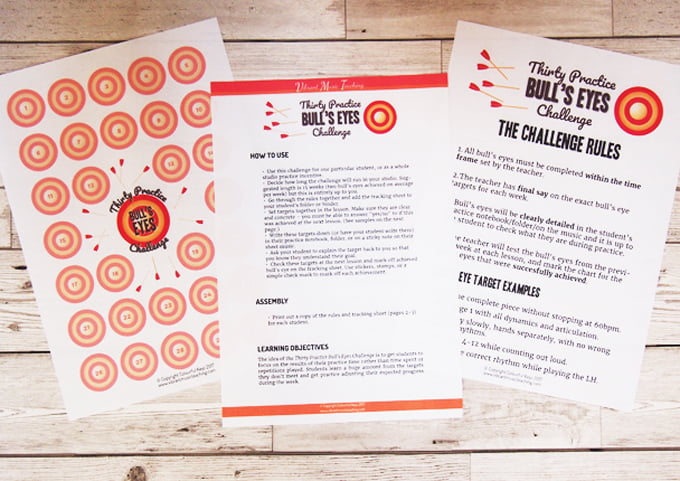
If you’re part of the VMT membership program, hop over to the library to download everything you need for the 30 Practice Bull’s Eyes Challenge.
Anytime, Anyone, Anywhere Excellence
The idea of the Anyone Anywhere Anytime list is to build up 10 pieces which a student:
- Loves
- Is super proud of & excited to show off
- Can play from memory
When they have 10 pieces which they’ve played in 6 different places/for 6 different people they have achieved “Anyone Anywhere Anytime Excellence”.
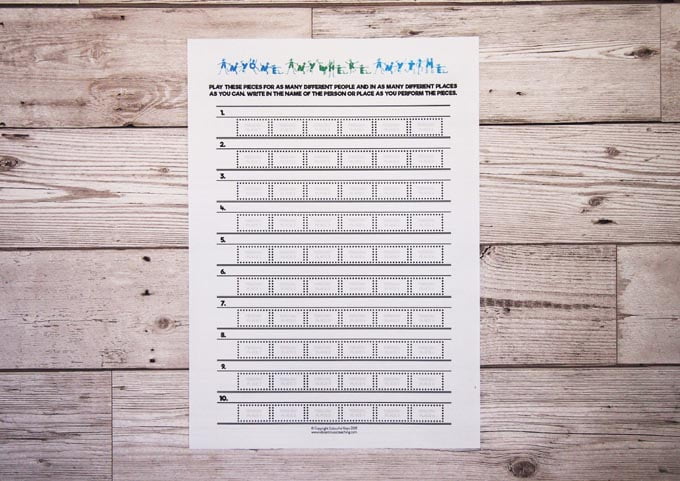
Now, the idea IS NOT the same as competition or exam pieces. We’re not trying to impress music experts here! These pieces should be fun for everyone – real crowd-pleasers, not the most difficult music your student can play. They should just really, really, love playing them and want to share them with people!
Are you a VMT member? Download the Anyone Anywhere Anytime tracking charts instantly from the VMT Library.

Subscribe to the newsletter and get the challenge posters and stickers
Enter your details to subscribe to the newsletter for piano teachers with information, tips and offers.
I hate spam as much as you do! I will only send you emails related directly to piano teaching and you can unsubscribe at any time.
Members can instantly download the full set of posters and stickers, including individual posters for each challenge.
How do you keep your piano students motivated?
Do you use a challenge board, or do you have another way to motivate piano students to work on the the less-than-exciting stuff? Let us know in the comments below 🙂.
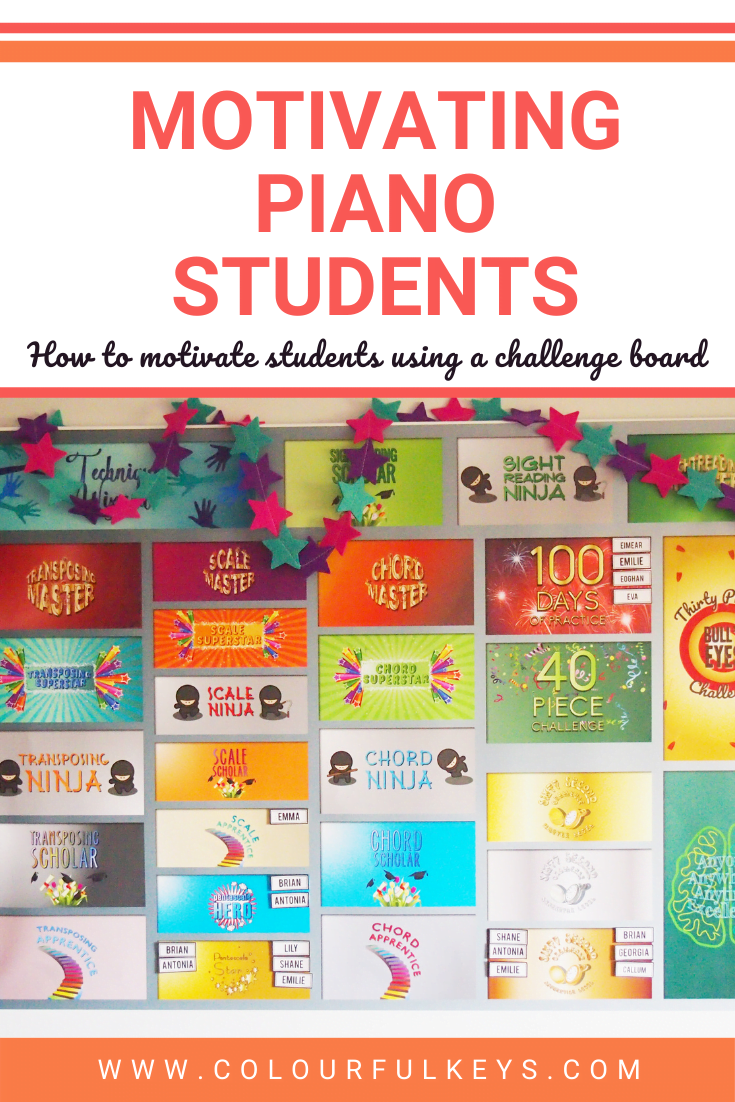
I love this idea, Nicola! It’s a little overwhelming to get going, but I think this is something I’ll work toward implementing in the next year.
I downloaded your posters and stickers and was wondering, how do you print the stickers small enough? They seem to be larger than an 8.5”x11” page, and I’m thinking you probably want them no bigger than 2 or 3 inches long and wide so you can easily stick multiple stickers on a student’s binder. Or am I missing something?
Thank you for everything you share with us! You’re in my top 3 favorite piano teaching blogs and I never tire of browsing through old posts looking for inspiration. 🙂
Thanks for all your lovely words Kara! I always appreciate your comments and insight. 🙂
Those stickers are actually very small, they’re designed to be sent to a professional printer (such as moo.com). If you want to print them at home, I suggest laying out multiple on a sheet – depending on the template of the labels you’re using.
Thanks NIcola! That makes more sense. 🙂
Love the idea,….. and having the poster and stickers would really help set it up, but I totally cannot figure out how to access them/print them. Great idea though.
Do you have everything up on a cork board? Or just poster board?
Thanks for the idea.
Have you entered your details in the box above Jacqueline? Did it not come through? Mine is stuck to my magnetic whiteboard and then the students’ names are on magnetic tape so I can easily move them around.
I love this idea! How did you print the names on the tape?
Very encouraging words. I’ll put these awesome piano learn the technique to work right away. It’s the little changes which will make the most important changes.
This looks so amazing…thank you for sharing.
I have downloaded the posters and stickers but am having problems printing. The stickers will only print one per page and will not allow me to move them to another document where I could place multiples on a page.
The poster will only print a small portion.
Any suggestions?
These are not designed for printing at home Elaine. The stickers are one per page so that they can be sent to moo.com or a similar printing service. The smallest poster is A2, the text would be unreadable at a smaller size.
Do you print most teaching materials at home on colour printer or you send them the professional printer ? If latter.,any recommendations? Saw you mention moo.com thanks !
Ps im UK based !
Most things I print at home but this poster and the stickers are professionally printed. For the stickers I highly recommend moo.co.uk and the sticker download above is perfectly set up for them. The poster I get printed at an Irish company, so you might want to look for someone more local for that.
I am going to start implementing two of these challenges for the summer. I am not sure which one yet, but I will decide within the next week or two. Do you have a recommendation on where to start? I was also wondering if you have stickers and posters for the songs in piano safari?
Again, thank you for all you do!!!!
Hey Laura, that’s great to hear. Depends really what your priorities are for your students? I think for a summer challenge the Anytime, Anywhere, Anyone (memorisation & performance) challenge might be a fun one; as would blasting your students up to speed with either scales or chords. 🙂
And no, I don’t do these specific to any method books since I (and other teachers!) use them with all sorts and I want them to work for everyone.
Hi Nicola, I had your previous charts up in my studio the last two years. Now I want to graduate to the new improved all-in one chart! About what size should it be printed to look good? I’m in the US so I am thinking 24″ by 36″ or 27″ by 40″. That’s approx. 61 by 91 cm or 69 by 102 cm. The “A2” size you mention doesn’t mean anything to me. Thank you!
I recommend you print A1 which is 594 x 841 mm or 23.4 x 33.1 in. Even if international paper sizes mean nothing to you, they should mean something to your printer! Just ask them for the closest to that and then to trim it down if necessary. 🙂
Thank you for your help! Stickers already on their way from Vistaprint, looking forward to getting the poster done and putting it all together!
Great! 😀
Thanks so much for this – your content, ideas, inspiration, and downloads are evergreen, which is quite the accomplishment!
Wanted to share an idea for making practical use of the poster in studio – I will be making my own template/design and getting the poster printed professionally. Then I’m going to put it behind “glass” with a 24×36 poster frame and let students sign their names on right on the “glass.” At the end of the year, it’ll be a simple as wiping it clean to start anew!
I don’t have as many sections, so each can be big enough to let multiple people write their names. I hope this actually works! I’ll let you know!
This sounds like a fab plan! Do let me know how it goes!
Hi Susan, how did the writing on glass method work for you?
How do you attach the names to the poster?
Magnets 🙂 (The whiteboard that the poster is mounted on is metal.)
I have a couple of questions about the poster challenge board. When you say the stickers go “on their folder” what do you mean? I do not have folders for each student. Is there a video for this explanation of how folders are used? Does each student get one name magnet, or a new name magnet for each challenge? I want to thank you for sharing your creativity with use. I only wished I had discovered you years ago!
Hi Barbara,
There is a deeper dive into the challenge board in this video on youtube: https://www.youtube.com/watch?v=lIQhzYXKzM0
Nicola talks about Student Folders here too: https://www.youtube.com/watch?v=89IvSzkfnLk
These might address some of your queries 🙂
Warm Regards,
Gemma
I have looked around everywhere and for some reason I can not find how to download the poster. None of the links go there. Can you help?
Hello! – I really like this idea and would like to have the materials to implement it… Can I purchase the items linked above without paying the annual membership fee?
C
Hi Cynthia,
We also have a monthly subscription plan, so you don’t need the annual one. It is not possible to purchase them separately, but we have a 30 day refund policy, so if you don’t like the resources our membership has to offer, you can ask your money back within 30 days of you subscription.
Warm regards,
Gabriel
This approach to reinforcing piano concepts is excellent on so many levels. I am about to start the challenge in my studio, but first would like to re-read the article on your site showing the six variations of the challenge some teachers use. Can you tell me where I saw that? Thank you, Nicola and everyone! Kit
Hi, Kit! Do you think it was this article? https://colourfulkeys.ie/motivation-tips-piano-teachers/